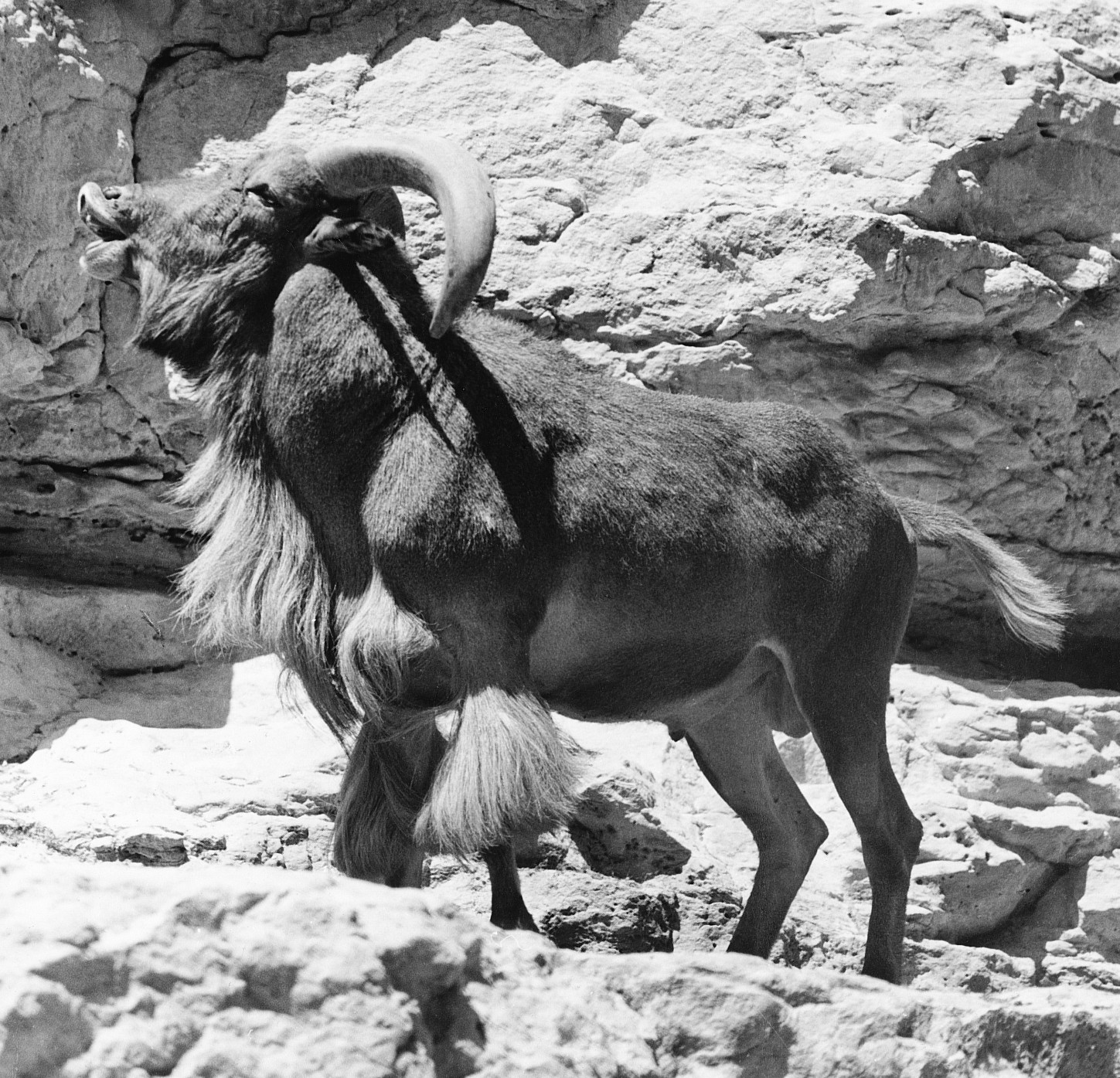BARBARY SHEEP OR AOUDAD*
Ammotragus lervia (Pallas 1777)
Order Artiodactyla : Family Bovidae
*Introduced species
DESCRIPTION. A relatively large sheep with horns curving outward, backward, and then inward and marked with strong transverse wrinkles; horns of females similar but somewhat smaller; tail relatively long, reaching nearly to hocks and with long hairs on terminal half; a conspicuous growth of long hair on throat, chest, and upperparts of front legs; no beard as is found in goats; upperparts and outer surface of legs uniform rufous or grayish brown; blackish middorsal line from head to middle of back; flanks, inner surface of legs, and belly whitish, but the chest colored like the sides; horns yellowish brown, darkening with age, set close together (nearly touching at the bases), and attaining a length of 50–80 cm. Dental formula: I 0/3, C 0/0, Pm 3/3, M 3/3 × 2 = 30. External measurements of a moderately large adult male: total length, 1,650 mm; tail, 141 mm; hind foot (tip of hoof to hock), 363 mm; ear, 116 mm; height at shoulder, 950 mm. Weight of males up to 145 kg; females to 65 kg.

DISTRIBUTION. Native to the dry mountainous areas of northern Africa; introduced into the Palo Duro Canyon area of Texas in 1957–1958, where it has become firmly established. Also present in the Edwards Plateau, Trans-Pecos, South Texas Plains, Rolling Plains, and Post Oak Savannah regions as a result of private introductions.
HABITS. The barbary sheep, or aoudad as it is known throughout Texas, is adapted to a dry, rough, barren, and waterless habitat, much as is the native bighorn sheep of our southwestern deserts. Consequently, it is quite likely that the two species could not survive together in the same area because of competition.
The aoudad lives in small groups comprising old and young animals of both sexes. They are expert climbers and can ascend and descend slopes so precipitous that humans can negotiate them only with great difficulty. Consequently, they are difficult to observe and more difficult to hunt.
Their food consists of a wide variety of vegetation including grasses, forbs, and shrubs. Apparently, they are capable of producing metabolic water and can survive for long periods without access to freshwater. When water is available, however, they utilize it for both drinking and bathing.
In studies conducted in New Mexico during the 1960s, Herman Ogren of the New Mexico Department of Game and Fish found that 79 species of plants were included in the diet of these sheep; of those, 13 were grasses, 20 were shrubs, and the remainder forbs. Mountain mahogany (Cercocarpus breviflorus) was the most sought-after single plant. Throughout the year, this species constituted nearly 22% of the items found in rumens of the sheep. Ogren found some seasonal variation in the diet. In winter, grasses were 86% of the rumen contents; browse, 11%; and forbs, 3%. In spring, summer, and fall the browse species, mainly oaks and mountain mahogany, made up about 60% of the diet; grasses about 26%; and forbs the balance. Over a year, browse species composed 49% of the diet; grasses, 42%; and forbs, 9%.
The breeding season appears to be rather extended, but most of the breeding is concentrated in the 2 months from mid-September to mid-November. The gestation period is about 160 days. Consequently, most of the lambs are born between late February and late April, but some lambs are born as late as November.
According to Ogren, females may become sexually mature at the age of 8 months, but normally they are older. All females 19 months of age or older that were collected in the fall and winter season were pregnant, lactating, or ovulating.
POPULATION STATUS. Introduced, common. Aoudad were first introduced to the United States in about 1900 and have been reared in zoos and on private preserves for a number of years. They were first released in the wild in New Mexico in 1950 and in Texas in 1957, when 31 were released southwest of Claude in Armstrong County. Thirteen more were released near Quitaque in Briscoe County. Today they occur along much of the eastern and southern edges of the Llano Estacado (along the Caprock Escarpment), in the rough country of the Trans-Pecos, and on parts of the Edwards Plateau, with a total population thought to exceed 5,000.
CONSERVATION STATUS. The IUCN lists aoudad as a species being vulnerable, although it does not appear on any federal or state lists of concerned species. Fewer than 10,000 individuals are thought to exist within its native range.
Whether this animal will eventually become a pest, as have most of the successful introduced animals, remains to be seen. There is some evidence that they compete directly with mule deer for food. They also have been observed feeding on winter wheat crops growing adjacent to Palo Duro Canyon. In the Trans-Pecos, aoudad may have a deleterious effect on bighorn sheep reintroduction efforts. The full effect of aoudads on Texas wildlife and rangelands has not been determined but should be carefully monitored in the future. It should be a priority to keep this species away from areas where efforts are ongoing to introduce native bighorn sheep.
REMARKS. Given the vulnerable status in the wild, the Texas population may become important as a source for reestablishing aoudad populations within its former native habitat.
From The Mammals of Texas, Seventh Edition by David J. Schmidly and Robert D. Bradley, copyright © 1994, 2004, 2016. Courtesy of the University of Texas Press.
Natural Science Research Laboratory
-
Address
Museum of Texas Tech University, 3301 4th street, Lubbock, TX 79409 -
Phone
806.742.2486 -
Email
nsrl.museum@ttu.edu

